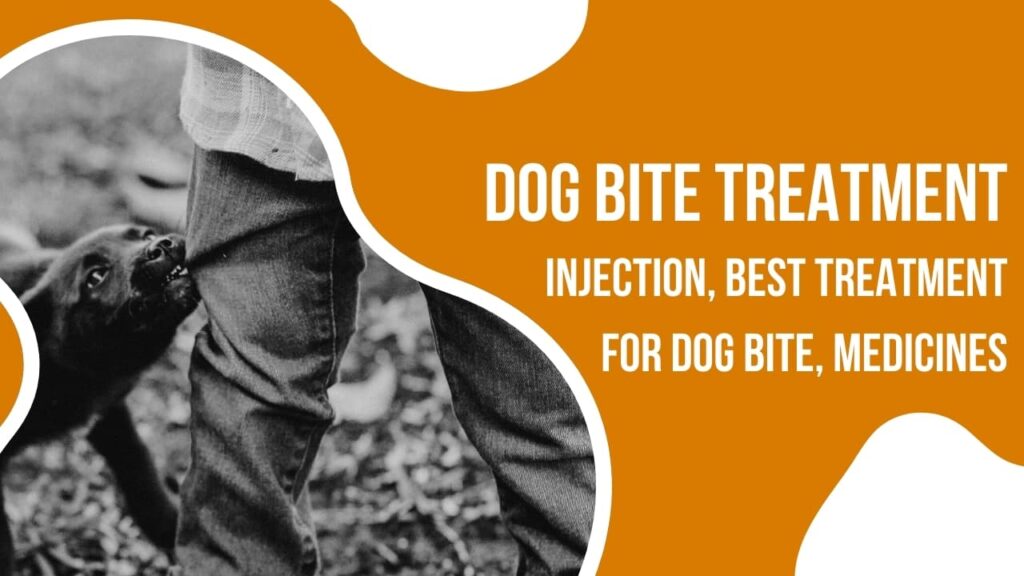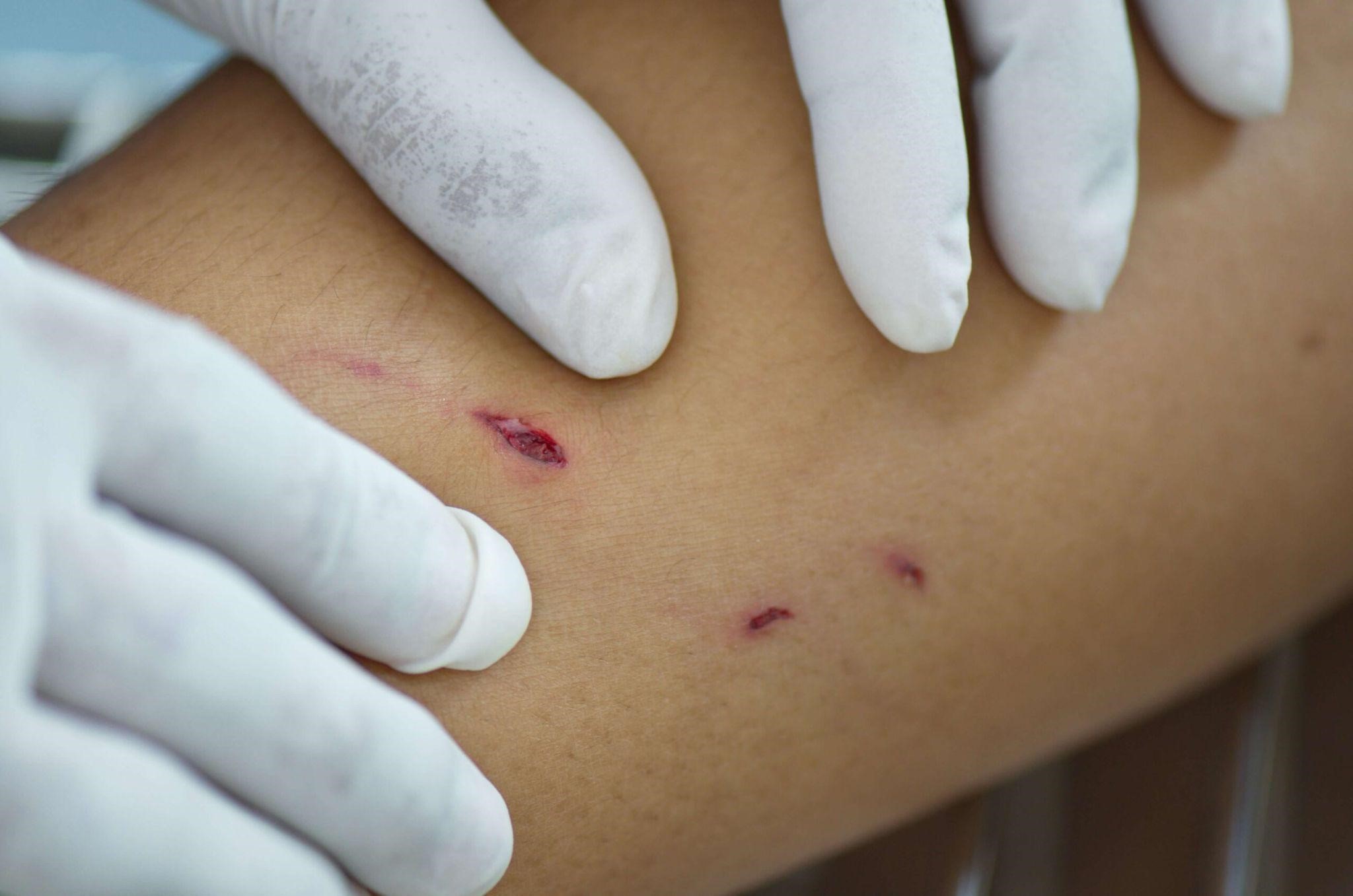Last updated on May 21st, 2025 at 01:09 pm

Understanding Dog Bites and Their Severity
Small nips to serious damage can result from dog bites. Size of the dog, biting power, and where the wound is on the victim’s body all have a role in how severe a dog bite is. Neural and vascular structures, as well as other important components, make bites to the face, neck, and hands more dangerous.
1. Evaluating the bite
Finding evidence of harm to the skin, underlying tissues, and bones is crucial when evaluating a dog bite. More serious bites can result in deep puncture wounds, ripped muscles, and fractured bones, whereas minor bites might just cause superficial lesions.
2. Possibility of Infection
Infection risk is one of the main issues with dog bites. Numerous germs that are present in dogs’ mouths might cause dangerous infections if they are not treated right once. Pasteurella, Staphylococcus, Streptococcus, and Capnocytophaga are examples of common pathogens.
3. The Value of Quick Action
Taking prompt action after a dog bite can greatly lower the possibility of results. In order to avoid infection and promote healing, quick medical evaluation, appropriate wound care, and vaccination are essential measures.
Initial Steps for Treating a Dog Bite
It’s critical to respond right away if a dog bites you or another person. In order to reduce the risk of infection and other problems, steps like these should be taken.
1. Sanitize the injury
Cleaning the wound carefully is the first step. To gently remove any dirt, debris, and bacteria, use warm water and a light soap. This lessens the possibility of infection and gets the site ready for additional care.
2. Limit Bleeding
If the cut is bleeding, use a clean towel or cloth to gently press on it to stop the bleeding. Reducing blood flow and swelling can also be achieved by elevating the affected area.
3. Utilize an antiseptic
Using hydrogen peroxide, a solution of or an over-the-counter antibiotic ointment as an antiseptic solution follows cleansing the area and stopping the bleeding. This lowers the infection risk even more.
Seeking Medical Attention
While small bites can frequently be treated at home, larger bites or any indications of infection should be treated by a doctor. Medical specialists are able to offer an improved assessment and suggest suitable courses of action.
1. When to Consult a Physician
If the bite is deep, starts to drain pus, or gets swelling, redness, or painful, you should consult a doctor. In addition, get medical help if the bite was from an animal that may be dangerous or if you have not had a tetanus vaccine in the last five years.
2. Expert Healing Treatment
In a medical evaluation, your doctor will examine the wound, give it a deeper cleaning, and maybe recommend antibiotics to keep it from getting worse. Sometimes a cut may need to be closed with stitches.
3. A Look at Rabies
It is possible for dogs and other affected animals to spread the deadly rabies virus through their saliva. A course of rabies vaccines may be advised by your healthcare professional if there is a danger of getting the virus.

Injections for Dog Bite Treatment
When it comes to avoiding infections and other problems following a dog bite, injections are essential. Injections of many kinds may be given, depending on the situation surrounding the bite.
1. Tetanus Vaccinations
Dog bites and other puncture wounds can result in the dangerous bacterial infection tetanus. To guard against this potentially fatal illness, your healthcare professional may suggest a tetanus booster shot if your tetanus vaccination is out of date.
2. Injections of antibiotics.
Oral antibiotics might not be enough to stop infection in certain situations. A larger concentration of medication may be injected directly into your bloodstream by your healthcare professional via antibiotic injections. In cases of severe bites or early illness symptoms, this may be very crucial.
3. The Rabies Vaccine
Rabies vaccinations are also necessary if there’s any chance the dog could be rabid. Four shots spread out over two weeks are usually administered as part of the rabies vaccination schedule. For added protection in between times until the vaccination takes effect, an injection of rabies antibodies may also be given.
Best Practices for Dog Bite Wound Care
Infection prevention and recovery from wounds depend on proper wound care. Following to optimal protocols can facilitate a seamless recovery and reduce problems.
1. Maintaining the Broken Area
Maintain daily cleansing of the area with a gentle soap and water. Cleaning or applying toxic substances on a wound could interfere with its healing process and cause more damage.
2. Watching for indications of infection
A rise in redness, swelling, affection, pain, or waterways from the site are all indicators of infection. Make quick contact with your healthcare physician if you have any of these symptoms.
3. The Right Bandaging
Use a clean, clean bandage to keep your wound covered. Replace the bandage every day, or more frequently if it gets filthy or hydrated. By keeping the wound covered, you can decrease the chance of infection by protecting it from debris and bacteria.
Medications for Dog Bite Treatment
Oral drugs are just as important in treating dog bites as needles are. In order to help you heal, your doctor might recommend a variety of drugs.
1. Antibiotics,
When treating or avoiding infections brought on by bacteria introduced by a dog bite, oral medications are sometimes suggested. Clindamycin, doxycycline, and amoxicillin-clavulanate are examples of common antibiotics.
2. Pain treatment
After a dog bite, soreness and suffering are frequent. Acetaminophen or ibuprofen, two over-the-counter pain medications, can help control discomfort and minimize inflammation. Your doctor may also recommend stronger painkillers in more severe situations.
3. Drugs that reduce irritation
Anti-inflammatory medications, including pain killers, can aid in reducing swelling and increasing healing. This is the usual use of nonsteroidal anti-inflammatory drug capsules (NSAIDs), such as ibuprofen and naproxen.
Long-term Care and Recovery
After a dog bite, recovery may be progressive, especially if the attack was severe. A thorough recovery and the avoidance of problems are dependent upon appropriate long-term care.
1. Physical Treatment
Dog bites can occasionally result in injury to the tendons, muscles, and nerves. To give the damaged area its function and strength back, physical treatment could be required. To help you heal, your doctor may suggest particular workouts and treatments.
2. Scar Management
Scars from dog bites may be uncomfortable or unattractive. Scar creams, silicone gel sheets, laser therapy, and other therapies can help reduce scarring. To choose the best course of action for your circumstances, go over these alternatives with your healthcare a doctor.
3. Mental and Emotional Assistance
Being bitten by a dog can be quite distressing, especially if there was significant damage if the dog was a family pet. A therapist or counsellor can provide you with emotional and psychological assistance while you process the event and deal with any ongoing dread or anxiety.
Preventing Future Dog Bites
Understanding the causes of aggressive behavior in dogs and taking precautions to reduce these risks are essential to preventing dog attacks. Education and awareness are essential for everyone, including healthcare professionals and dog owners.
1. Recognizing Dog Behavior
Dogs may bite for a number of causes, such as ownership, fear, or pain. Recognizing and addressing possible triggers before a bite happens can be made easier by being aware of the typical symptoms of aggression, including as growling, snapping, and stiff body language.
2. Teaching and Socialization
In order to stop aggressive behaviour in dogs, proper socialization and training are crucial. Dogs can feel more at ease and be less prone to bite if they are exposed to a range of people, animals, and situations from an early age. Dogs who receive obedience training can also learn how to obey commands and act appropriately in various contexts.
3. Guidelines for Safe Interactions
Dog bite risk can be decreased by promoting safe engagement techniques. Teach adults and kids to avoid actions that can agitate dogs, including grabbing their tails or ears, and to approach them politely and calmly.
Conclusion
Dog bites are a severe issue that need to be treated right away to avoid complications. You may guarantee a successful recovery by being aware of the procedures for providing prompt wound care, the significance of seeking medical treatment, and the function of injections and medications. A full recovery also depends on receiving the appropriate long-term care, which includes physical therapy, scar management, and emotional support. Ultimately, you and others can be kept safe by adopting preventative measures including education, socialization, and safe interaction techniques to avoid dog bites in the future.
Seek advice from a veterinarian or other healthcare provider for more specific instructions and tailored suggestions. Working together, we can make the environment safer and healthier for dogs as well as people.
FAQs on Dog Bite Treatment
1. How should I react to a dog bite immediately?
Use a new antibiotic to bind the cut after cleaning it with soap and water. Seek medical attention if the bite is severe or shows signs of infection.
2. When is a rabies vaccination required after a dog bite?
If the dog that bit you is unknown and has never been vaccinated against a virus or is showing signs of medical conditions, speak with a medical expert about starting a rabies vaccination series.
3. How can dog bites be avoided?
Learn to identify a dog’s warning signs, train and train your dog correctly, and conform to safe interaction rules. You can protect the wellness and health of your animal family members as well as yourself by being knowledgeable and organized.
